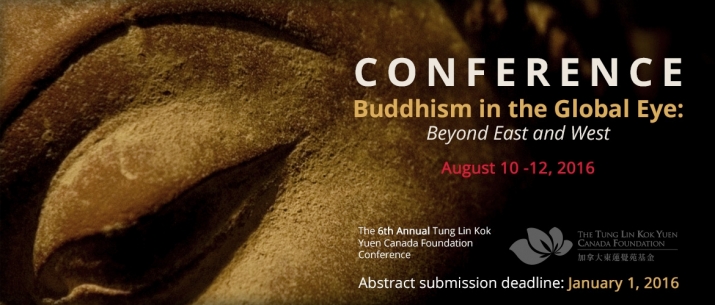NEWS
Sixth Annual Tung Lin Kok Yuen Canada Foundation Conference Releases Call for Papers
 From ubc.ca
From ubc.caThe 6th Annual Tung Lin Kok Yuen Canada Foundation Conference, “Buddhism in the Global Eye: Beyond East and West,” has issued a call for papers from interested scholars around the world. The conference is scheduled from 10–12 August 2016, and the submission deadline for abstracts is 1 January.
Hosted by The Robert H. N. Ho Family Foundation Program in Buddhism and Contemporary Society at the University of British Columbia and co-sponsored by The Modernization of Buddhism in Global Perspective Project, the conference will explore and question assumptions behind the study of modern Buddhism as “Western” Buddhism. It aims to re-examine the supposition that modern Buddhism is defined as “Buddhism with Western characteristics,” and to try to map out a more rigorous paradigm for explaining the modernization of Buddhism. Key to this objective is the concept of globalization, which does not isolate Buddhist transformation in a particular region like the West or Asia but emphasizes mutual communication across diverse nodes that cross East-West lines.
Scholars interested in presenting at the conference should submit a paper proposal (200 words), a short biography (100 words), and a single-page CV to bcsprogram@gmail.com. Graduate students selected to present will receive up to three nights’ free accommodation at the UBC, plus a modest honorarium depending on the distance traveled.
Scholars are invited to present based on the following rubrics:
The “Westernization” paradigm: Much writing on the modernization of Buddhism assumes that the process started when Buddhism came from Asia to the West and adapted to Western culture. In this paradigm, the modernization of Buddhism basically consists in Westernization; the acquisition of features of Western culture such as egalitarianism, gender neutrality, individualism, and so on. This paradigm has several faults.
- Modernization begins in Asia. The Westernization paradigm ignores the historical fact that Buddhist modernization movements first arose in Asia. By the end of the 1800s, Ceylon had “Protestant Buddhism” and Japanese thinkers were actively trying to create shin bukkyo, or New Buddhism. In the 1920s, the Chinese monk Taixu started to define renjian fojiao, or humanistic Buddhism. Today, the best organized transnational Buddhist institutions are based in Asia.
- Asian agency. The paradigm assumes that traditional Asian Buddhism lay inert until the coming of the West jolted it into reform, that in the modernization process Asian Buddhism lies passive as Western influences reshape it. However, in Thailand, even before the approach of Western powers, in 1851 King Mongkut initiated the reform of Buddhism. And in modernization movements in other Asian countries, the Asian side was never a mere passive foil; it was an active agent mobilizing all available cultural resources to reform its local form of Buddhism.
- Multiple nodes. The modernization of Buddhism is not a one-way imposition of ideas from West to East. Monks traveled between Asian countries, creating networks mutually stimulating each other’s modernization movements. The Japanese monk Shaku Soen witnessed the modernization in Ceylon before returning to Japan. Thich Nhat Hanh developed Taixu’s renjian fojiao into “socially engaged Buddhism.” The creation of these complex networks linking multiple nodes transmitting information, influence, and funds is the dynamic of globalization.
- Authenticity. Some authors have bluntly claimed that Westernized Buddhism is much closer to the Buddha’s original teaching than traditional Asian Buddhism. Here Western Buddhism masks a self-congratulatory ethnocentrism. At issue here is authenticity and claims of authority which need to be explored more critically than has been done so far.
- Global forms. The forms of modern Buddhist activity in Asia are not mere imitations of Western “possessions.” Viewed from a global perspective, these forms are clearly seen as organizational, behavioral, and cognitive institutions taken up by religious and secular groups within a global exchange of forms. Buddhist engagement with, and development of, political ideologies, human rights, charitable and social work, chaplaincy, healthcare, youth culture, and education, are just that: Buddhist engagements. Further work is necessary to unearth the complex and embedded local situations of these authentically Buddhist engagements.
- The emergence of secularity and a modern concept of religion. Up to the 1800s, religions were classed under four categories: Christianity, Mosaism, Mohammadanism, and heathen paganism. As they learned about other religions, people abandoned this Christianity-centered system and triggered a modernization of the concept of religion itself. The idea of secularity, the granting of respect for other religions, and the concept of a “world religion” were born.
This conference will seek to understand the modernization of Buddhism under a truly global paradigm. To understand and explain any phenomenon associated with modern Buddhism, the global networks and transnational flows that have been at work since the 19th century must be factored in. Some topics, questions, and issues that could be discussed include:
- Ethnographic case studies and historical studies of the modernization of temples, monasteries, religious communities, business organizations, and other groups in Asia.
- Theoretical explorations of ways to describe the modernization of Buddhism that move beyond the Westernization paradigm.
- Critical approaches to religion. How have societies in Asia contributed to a modern conception of “religion,” or to a modern conception of “world religion”?
- How has the globalization of the concept of “religion” affected the way that Buddhism has been, and is being, reconstructed?
- How have modernization projects taken different forms in different places, recognizing processes of localization, or “glocalization.”
- Critical approaches to authenticity. The question of authenticity arises wherever Buddhism modernizes. Who claims authenticity? What is the criterion of authenticity. and what are the consequences of these claims?
- What synergies operate across the East-West divide in Buddhism? What synergies fail to operate across the East-West divide?
For further information, please email:
- Jessica L. Main (jessica.main@ubc.ca)
- John S. Harding (john.harding@uleth.ca)
- Victor Sogen Hori (victor.hori@mcgill.ca)
- Alexander Soucy (Alec.Soucy@smu.ca)
See more
Call For Papers: Buddhism in the Global Eye — August 10–12, 2016 (UBC)














